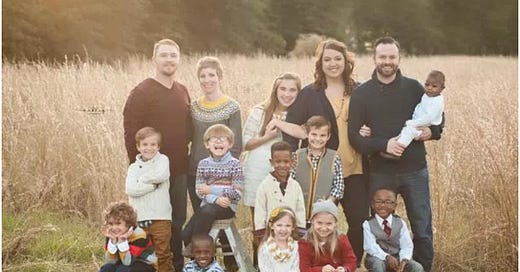Why Do Adoption Assistance Payments in Ohio Average Less Than 50% of Foster Care Payments?
More than 70% of Ohio children who are adopted from foster care are adopted by their foster parents. And among children placed for adoption by Ohio county agencies, nearly all are eligible for subsidies paid for with the help of the federal government.
These adoption subsidies are potentially available up to the individual child’s monthly foster care payment. Yet, average adoption assistance payments in Ohio are less than half of average foster care payments. During the July-September quarter of 2021, for example, the average monthly foster care payment was $870, compared with an average adoption assistance payment of $414. The greater the child’s care needs, the greater the gap.
Why such a large gap, when we are talking about the same children who just before their adoption merited hundreds of dollars more per month in support? A big reason appears to be the erosion of federal support for the state’s foster youth, the result of an eligibility requirement pegged to an income limit that has not changed in over 25 years.
Title IV-E is a federal entitlement that reimburses states for most of the costs related to foster care support and adoption assistance. In Ohio, the federal reimbursement rate is currently 64% of each IV-E foster care and adoption assistance payment. Around 95% of Ohio children adopted from foster care are eligible for IV-E Adoption Assistance.
But child eligibility for federal IV-E foster care payments is still pegged to an income test from a public welfare program that hasn’t existed for a quarter-century. The old public welfare program (AFDC) was abolished and replaced by a new public assistance program in 1996, but continues to function as an eligibility standard for IV-E foster care payments. Children must have been removed from homes that meet a poverty standard from 1996 in order to qualify for IV-E foster care reimbursements. By 2015, Ohio IV-E foster care eligibility rates fell below 60%; by 2019, the eligibility rate was 51%. (See attached file).
This left Ohio counties responsible for 100% of the costs of care for increasing percentages of foster children in their custody. Because, adoption assistance payments are supposed to be determined through negotiations with individual families, there is strong institutional pressure to push for monthly payments that are significantly lower than the child’s foster care payment rate.
Research tells us that adoptive parents are people of relatively modest means. Adoptive parents must address the often severe mental health and developmental deficits foster children bring with them, along with providing for the ordinary needs of a stable family. Surveys indicate a substantial majority of adoptive parents regard adoption assistance as essential to providing permanent families for their special needs children.
Obsolete IV-E foster care eligibility requirements are not the only thing to blame for this chasm between supporting foster and adoptive families. Unlike other federal programs, adoption assistance payments are negotiated between parents and county agencies. In Ohio’s county administered system, there are no statewide payment rate schedules to serve as guidance for determining the amount of monthly adoption assistance. County agencies often take approaches to negotiating adoption assistance with adopting parents that are wildly out of synch with federal and state policy.
The result is a contentious, time-consuming process with no effective path to resolution. Some adopting parents give up and settle for adoption assistance payments they know to be inadequate. Others fight on for months or even years.
In November 2020, Governor Mike DeWine’s Children Services Transformation Advisory Council acknowledged this problem, noting a need to improve “consistency in the adoption subsidy negotiation process.” There have been no major policy changes so far, but the Bureau of State Hearings has revised its approach to Ohio’s mediation of disputes over the amount of adoption assistance that bears watching. One of the mediators confided that all of their cases over the past year resulted in negotiated settlements, indicating agreements for higher adoption assistance payments.
State mediators do not have the authority to determine the amount of adoption assistance, but active participation by a state official with in-depth knowledge of the adoption assistance program can walk the parties through important considerations that are often neglected, such as family circumstances. Early returns are promising. One of the recently hired mediators confided that all of her cases over the past year resulted in negotiated settlements, indicating agreements for higher adoption assistance payments.
But mediation alone is not sufficient to close the large gap between foster care maintenance payments and adoption assistance. County agencies can still refuse to negotiate without negative consequences or only agree to a somewhat higher, but still inadequate, adoption assistance payment. Congress must finally abolish the outdated AFDC 1996 income test that serves as an eligibility for Title IV-E Foster Care Maintenance. And the state of Ohio must confront the structural disincentive to negotiate adequate adoption assistance agreements with parents adopting special needs children from foster care.




